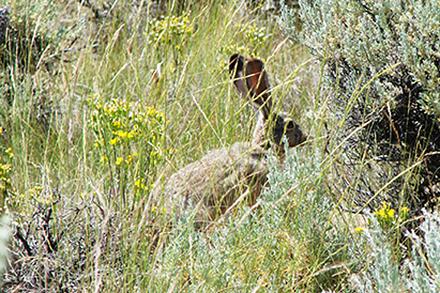Large Appetites Hinder Rebuilding Efforts

Study shows that jackrabbits and other herbivores can slow down ecosystem restoration efforts in in the Great Basin. (Photo courtesy of Kirk Davies, D5102-1)
The sagebrush steppe habitats in “flyover country” cover over 160 million acres in 11 Western states, including the Great Basin. This delicate ecosystem is blanketed by abundant sagebrush, but also contains a diversity of other native shrubs, grasses, and flowering plants.
“The sagebrush steppe is more than just sagebrush,” said Kirk Davies, rangeland scientist with the Agricultural Research Service’s (ARS) Range and Meadow Forage Management Research unit in Burns, OR. “It’s important because it is a critical habitat element for many native wildlife species such as sage grouse, which are a species of conservation concern.”
Davies and other researchers are examining how to help restore that delicate system in an effort to overcome and reverse many years of land mismanagement. The effects of overgrazing cattle and horses have led to stronger partnerships between researchers and Great Basin land managers who are faced with the task of rebuilding.
The problem is that large sagebrush often hinders the development of critical understory plant growth. An ARS study examined the problem and found that the solution is not as simple as one might think. Drill-seeding targeted areas with perennial bunchgrass (using equipment to plant uniform rows of seeds) successfully introduces new growth, but that’s when the trouble starts.
Invasive annual grasses often limit the ability of new seeds to take hold, and those seeds that do manage to sprout then must contend with animals that feast on the seedlings like a salad bar. While researchers and land managers have been able to work with ranchers to keep horses, cattle, and sheep from grazing the area, smaller herbivores like jackrabbits have a free pass to roam the range. That often limits restoration efforts and contributes to the persistence of degraded understories.
According to the ARS study, restoration efforts would work best if land managers took jackrabbits and other small herbivores into account when developing and implementing their restoration strategies. By limiting their presence in these sagebrush communities, land managers are giving this ecosystem a chance to regenerate and thrive. – by Scott Elliott, ARS Office of Communications.
You May Also Like:

